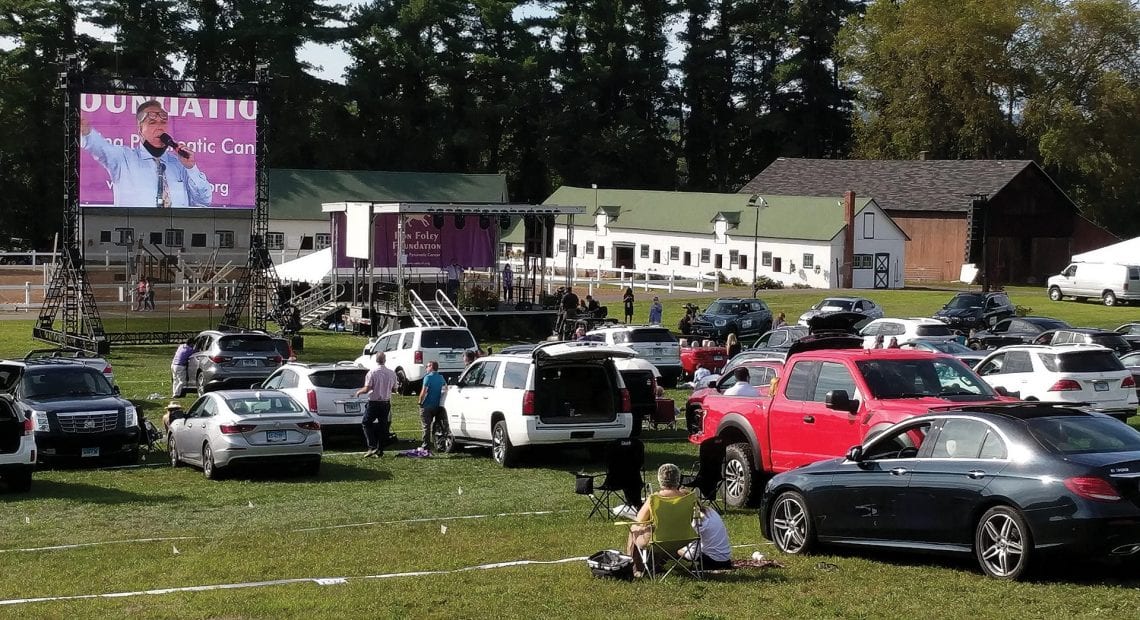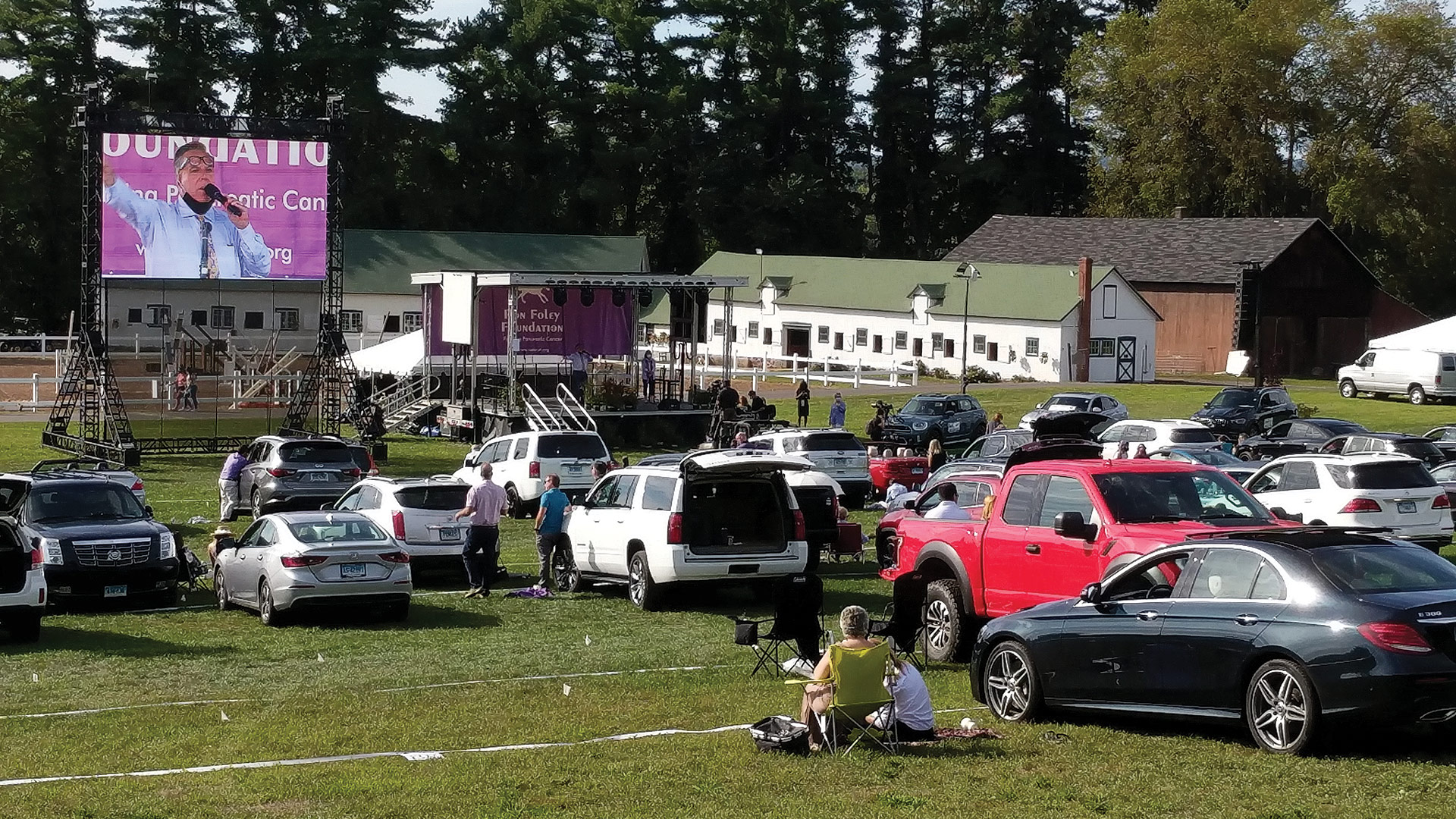
Event-production Companies Turn to Virtual Events to Fill the Void
Remote Connections

Zasco Productions recently held a hybrid drive-in event for a pancreatic-cancer organization — one way it’s filling the void with live events curtailed.
While most of the business world slowed gradually in March, or even ground to an eventual halt, the story was more dire for the events industry.
It just … stopped.
“When the whole country shut down, we were impacted immediately. We were one of the first business sectors to really feel the effects,” said Andrew Jensen, president of Jx2 Productions, noting that among the state’s first orders was barring large — and eventually even modestly sized — gatherings.
Within a day or two, he recalled, “we had no business left, just one or two things left for the rest of the year. Everyone freaked out. From weddings to live events to conferences to concerts, everything was gone overnight. It was non-stop with the phone calls. It was unlike anything I’ve ever felt. When there’s some kind of natural disaster or act of God, everything might be off for a while in one area, but never worldwide like this.”
After hunkering down for a while to get a sense of what was to come, it was time to get off the mat and figure out how to move forward in 2020. In Jensen’s case, like most players in his industry right now, that meant a shift to a new type of virtual, or online, event.
“Like any major shift in business, it’s a learning curve; it’s a challenge to make the transition from only live events with some streaming at them to all streaming events. It was definitely a shift not only in our business, but in the mentality of people asking to do them.”
“Like any major shift in business, it’s a learning curve; it’s a challenge to make the transition from only live events with some streaming at them to all streaming events,” Jensen explained. “It was definitely a shift not only in our business, but in the mentality of people asking to do them.”
The typical live gathering might include livestreams as a secondary factor, he said, mostly at higher-end events; smaller companies typically don’t bring in a secondary audience remotely. “We had to shift our mentality, and that was hard. Did we have redundancies and protocols in place? What if we lose somebody on the other end? How does that effect everyone?”
Michael Zaskey has been dealing with those questions, too, since the industry crashed to a halt in mid-March.
“We were the first to go, and we’ll be the last to come back in a traditional sense,” the owner of Zasco Productions told BusinessWest. “We knew pretty quickly that online and virtual events were going to be the norm for a while.”
At first, companies thought they could take a DIY approach, he added. “Initially, folks were trying to do things with Zoom and GoToMeeting. Those are awesome tools for meetings or small-group sessions, but not for producing events. You can have a board meeting or discussion over Zoom, but if you want to engage and entertain and create an experience similar to a live event, that’s not the right tool. You still need a production company.”

Jx2 Productions has boosted the technology in its control room, and out on the road, to meet the needs of a largely virtual event landscape.
The world is figuring that out. Based on projections from Grand View Research, virtual events will grow nearly tenfold over the next decade from $78 billion to $774 billion. And that puts a squeeze on businesses like Jx2 and Zasco.
“People figure a virtual event costs less than a live event because you’re not renting ballroom space, but on the production side, it’s just as expensive, or even more,” Zaskey said. “We’ve tried to be flexible with budgets, but we’re working with a very slim margin.”
It’s a challenge that will remain, at least in the short term.
“Obviously, it will be a long time before live events come back full force,” he added. “Virtual events will never replace a live event, which is so much about the networking, and people miss that. But in this time of pandemic and crisis, they’re viable solutions that allow people to connect and participate.”
Technical Concerns
The first thing people need to learn in this new landscape is the terminology, Zaskey said. “Like, when people started using the phrase ‘socially distant,’ I’ve always thought we say that wrong. We should be socially connected and physically distant. Or connected with technology.”
Likewise, people often mean different things when they say ‘virtual event.’ “People started throwing that term around, but it means something different for every person we talk to.”
That’s because, in his world, virtual events have often meant events that occur in a virtual space, like a corporate meeting in which the CEO stands on a virtual stage in front of a greenscreen, backed by a set created electronically, as if standing in a video game or virtual-reality environment. “What most people call a virtual event today, we use the term ‘online event.’ That’s more accurate.”
There are hybrid events, too, which mix in-person and remote elements. “Instead of 500 people in a room, maybe you have 20 smaller rooms with 25 people in each room, physically distanced, and connect those rooms electronically” — a good option even in non-pandemic times for large, national companies that don’t want to fly everyone to one location for an important gathering.
Zasco is also doing some drive-in events, like a recent pancreatic-cancer fundraiser in Connecticut that had been postponed from May. “We wanted to keep our audience engaged, so we did a drive-in event and spaced out the cars, with a large screen outdoors, and you could listen through FM radio.”
While short speeches were delivered on stage — again, in a distanced fashion — the biggest donors and benefactors attended live in their cars, with others able to watch through a webstream.
“We’ve done a number of those for nonprofits, schools, and corporations,” Zaskey said. “That’s been pretty successful. I’ve been impressed how good people have been about following the rules. People, by and large, are wearing masks and staying in their cars. I’ve been impressed, because people aren’t always known for following rules.”
“We’ve done a number of those for nonprofits, schools, and corporations. That’s been pretty successful. I’ve been impressed how good people have been about following the rules. People, by and large, are wearing masks and staying in their cars.”
One pressing issue at online and hybrid events, of course, is connectivity and having the redundancy and bandwidth to keep connections from going down. “We’ve had to think and engineer our way into … not necessarily new technology, but using it in new ways. It’s always changing and growing.”
Part of the challenge is communicating issues to attendees, he added. If a hotel ballroom loses power, all 500 people attending in person experience the same thing and know what’s going on. “If 500 people tune into a stream and lose power to the master control room, those 500 people have no idea what happened.”
Jensen agreed that technical concerns were paramount. “It was slightly challenging at the beginning for us tech people,” he said, adding that another challenge has to do with communication — not only with the crew, but with presenters who may be in different locations.
“We’ve done thousands of events over 20 years, and the process is different. We’d have a stage manager go on stage and hand someone a microphone. Now you have to make sure you have plenty of rehearsals and walk them through the process.”
Technology upgrades are a must as well, both for production companies and their clients. “A standard laptop camera and microphone don’t work — certainly it’s not high-enough quality. So we created ‘cases’ and sold a couple dozen to clients, and have some in own inventory. This allows them to have much better image and quality and make their event that much better. We all know a standard iPhone camera or computer camera is not that great.”
Like Zasco, Jx2 found a niche in drive-in events, like graduations. And because the company got into streaming at least 15 years ago, as it went mainstream, it wasn’t too difficult to shift focus to that side of the business this year. “We kind of already had a foot in the door.”
One upside to the current situation, Jensen said, is that it’s forced businesses to think differently about their events.
“It’s a chance for our clients to think outside the box and become OK with not doing things the standard way, the rinse-and-repeat event you’ve done for 10 or 20 years. You get used to doing things a certain way: guests arrive at this time, you do a cocktail hour, there’s a formula to every live event.
“Now, you’re trying to recreate something where the guests’ attention span is definitely lower because it’s virtual, and you’ve got a lower level of interaction from guests,” he went on. “You’ve got to make sure whatever you put on the screen will resonate with guests.”
Working creatively to achieve that goal, he said, can often spark inspiration for future events as well, even the live ones that will return … someday.
Optimistic Outlook
Zaskey is looking forward to that day.
“We’re pretty fortunate to be pretty busy, but the profit margins are not the same as they are for live events,” he said. “The entire industry is still struggling greatly.”
Much of the staff laid off in March has come back on a part-time basis as jobs are scheduled. “A lot of what we’re doing, we have to deeply discount, not just to be a good neighbor and help clients so they can pull out of this as well, but to keep our people working.”
One long-term concern is a possible ‘brain drain’ as the pandemic wears on, he added.
“The industry is at risk of losing talent, and that scares us a little bit. As people get desperate and wonder about the future, they might consider career changes. Maybe they’ll come back, but maybe they won’t — maybe someone has always wanted to be a chef, and decides it’s time to go to culinary school. When the world bounces back and live events come back, we need highly skilled people to work on them.”
And events will come back, Jensen said, if only because people desperately want to attend them. “Human nature is interactive; we want to see people, be with people, go to dinner, go on vacation. Most people aren’t homebodies. People over the summer couldn’t wait to go to the beach or go camping. You couldn’t buy a kayak.”
In the same way, “I think live events will come back massively once we get through this pandemic and the comfort level comes back up.”
In fact, Jensen predicts bottlenecks as venues book up quickly once they get the go-ahead from the CDC and state officials. “I think it’s going to be the end of ’21 into ’22 when events pick up fully. We’re a couple years out from full recovery. But people will be eager to plan these things.”
Zaskey agreed. “It’s still very, very tough, and it’s going to be tough for a long time,” he said, but he looks back to 9/11 for a possible parallel. Events suffered mightily after that tragedy as well, but 2002 through 2004 were Zasco’s biggest growth years.
“People wanted to get back to live events. And I think the same thing will happen when the pandemic is over. Getting to that point is the challenge.”
Joseph Bednar can be reached at [email protected]





